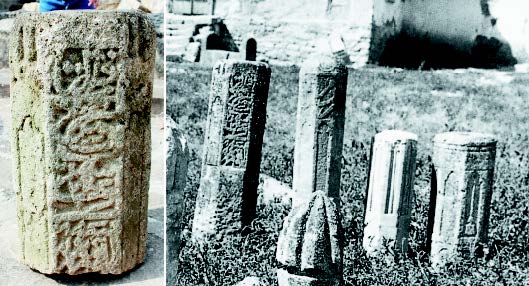STARY KRYM MUSLIM GRAVESTONES OF THE GOLDEN HORDE PERIOD (EXEMPLIFIED BY A SUBTYPE IN THE FORM OF AN OCTAGONAL PRIZM WITH NO FIGURED TOP SECTION)
Keywords:
Stary Krym, Golden Horde, epigraphy, gravestones, vertical octagonal tombstonesAbstract
The article considers a subtype of Muslim gravestones dating back to the Golden Horde period represented by a vertical octagonal prism with no figured top section. The gravestones have been recorded in the territory of Stary Krym.
The study of the monuments in the form of octahedral prisms allowed to identify a total of two subtypes. The analysis allowed to determine the differences in the functional purpose of the two subtypes:
– with a figured top section and the upper part of the monnument resembling a durbe dome or a men’s headdress in terms of the shape. The inscription primarily conveys information on the name of a person in the Arabic language, as well as a nasab and a nisbu.
– without a figured top section; the inscription on these tombstones only conveys information on the date of death of the buried in the Arabic language.
A total of 318 (39 %) gravestones of 318 dating back to the Golden Horde period were classified as the vertical octagonal prism type, 31 of which correspond to the subtype with no figured top section.
On the whole, an analysis of thirty-one gravestones corresponding to the given subtype revealed the basic design techniques and characteristic features typical for this gravestone subtype. An analysis of decoration elements used in the design of gravestones demonstrated the presence of a Seljuk influence.
The interpretation of inscriptions on twelve gravestones demonstrated that they correspond to the seventh century A.H. (14th century A.D.). Stylistic similarity allows to attribute all the monuments of this subgroup to the Golden Horde period.
References
Акчокраклы О. [-Н. А.] Старо-Крымские и Отузские надписи XIII–XV вв. // ИТОИАЭ. Симферополь, 1927. Т. 1(58). С. 5–17.
Акчокраклы О.-Н.А. Старо-Крымские надписи: по раскопкам 1928 года // ИТОИАЭ. 1929. Т. 3. С. 152–159.
Бороздин И.Н. Солхат // Новый Восток / Под ред. М. Павловича. М., 1928. № 13–14. С. 271–301.
Коран / Пер. И.Ю. Крачковского. Душанбе, 1990. 447 с.
Крамаровский М.Г. Солхат-Крым: к вопросу о населении и топографии города в ХIII–ХIV вв. // Итоги археологических экспедиций. Л., 1989. C. 141–157.
Крамаровский М.Г. Крым и Рум в XIII–XIV столетиях (Анатолийская диаспора и городская культура Солхата) // Золотоордынское обозрение. Казань, 2016. № 1. С. 55–88.
Фонды БИКАМЗ. КП-10740/405. Дневник У. Боданинского. 1925. Л. 45.
Biçici H. Kamil. İznik Müzesindeki Kandil ve Şamdan Motifli Mezar Taşlar // Turkish Studies – International Periodical For The Languages, Literature and History of Turkish or Turkic. Ankara, 2012. Vol. 7/3. p. 637– 661.
Çal Halit. Türklerde mezar-mezar taşlari. // Aile Yazıları, 8, TC. Aile ve Sosyal Politikalar Bakanlığı Yayını. Ankara, 2015. S. 295–332.
Delikgöz Ömer, Fulya Aliç. Osmanli Istanbul’unda bulunan bazi müslim ve Gayrimüslim mezarliklarindaki kimi semboller // Hacettepe Üniversitesi Türkiyat Araştırmaları Dergisi. 2010. № 13. S. 113–131.

Downloads
Published
How to Cite
Issue
Section
License
Copyright (c) 2017 M.A.Useinov

This work is licensed under a Creative Commons Attribution-NonCommercial 4.0 International License.







